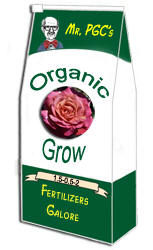Again, your soil test result will
indicate the levels of all of the macro and certain
micro nutrients currently present in your soil. It will
then look at the crop you intend to grow i.e.
perennials, turfgrass, fruit trees, etc. and will make a
recommendation of amounts of various nutrients you might
need to apply.
Since the test will not typically test for nitrogen, it
will just recommend the amount needed for your crop
during a growing season. However, the amounts of the
other nutrients recommended will be based on the needs
of the plant minus the amount that is already present in
your soils. For some nutrients such as phosphorus which
can build up in the soil over years, you may not need to
apply any. Rely on the soil test results for the
specifics.
Generally speaking, there are two broad categories of
fertilizers used by the home gardener; Inorganic and
Organic. There are a lot of philosophical debates over
which of these two is "better" and each of you will have
to make up your own mind. Here, we will just tell you
the pros and cons of each type.
A. Inorganic Fertilizers - These are mineral nutrients which
companies either dig from the earth or extract from the
air and put into forms that can be distributed to the
home gardener. The most common form is the granular
product that you purchase by the bag at the nursery or
hardware store. They can also come in a form that can be
mixed with water and applied as a liquid solution.
These types of fertilizers are known for being highly
water soluble. They will dissolve in water and move
quickly into the soil. Of course, if improperly applied,
they may also flow off the surface and into nearby water
courses. But, on the plus side, they are very quickly
available to the roots of the plants. They do not need
to go through any preliminary processes before they are
usable.
Fertilizers in this form generally contain a fairly high
to a very high percentage of actual nutrients. They are
also in a chemical form called a salt. So, if you over
apply them or if large amounts come into direct contact
with plant foliage or roots, they will "burn". This
means that they will cause the water in the tissues of
the plant to move from the plant into the salt very
quickly which will kill the cells of the plant tissue.
The pro part of this is that you can apply relatively
small quantities of the fertilizer and get a big
response from the plants.
B. Organic Fertilizers - If you every took organic chemistry (I
really struggled with that myself.), you know that the
term "organic" deals with compounds that contain carbon.
We and all the other life on earth are carbon based
organisms. (BTW - I faintly remember a Discovery channel
report on some deep sea creatures based on something
other than carbon...but that is another story.) So, when
we talk of organic fertilizers, it basically means that
these come from something that was once a living
creature i.e. animal or plant.
 Typical organic fertilizers can range
from animal manures to various composted products.
Unless you live in a rural area, you will generally be
limited to using composted materials. Composting, of
course, is the process of allowing things to rot until
they have broken down into their constituent parts. I
always ask people how they know when their compost is
"done?" The answer is, "When you can't tell what it was
before." That is why composted cow
manure does not look
or smell like manure. It is just basic organic matter.
Typical organic fertilizers can range
from animal manures to various composted products.
Unless you live in a rural area, you will generally be
limited to using composted materials. Composting, of
course, is the process of allowing things to rot until
they have broken down into their constituent parts. I
always ask people how they know when their compost is
"done?" The answer is, "When you can't tell what it was
before." That is why composted cow
manure does not look
or smell like manure. It is just basic organic matter.
From a nutrient standpoint, organic fertilizers have a
couple of unique properties. One is that they will have
very low percentages of the various nutrients. Having a
few percent of any individual macro-nutrient would be a
high analysis for an organic fertilizer. The advantage
to this is that they are not "hot" fertilizers and over
applications won't generally result in plant burn. The
down side is that you might have to apply larger amounts
to meet the nutrient requirements of your plants.
Unlike the inorganic fertilizers, organic sources need
to go through another step or two before the nutrients
will be available to the plants. Bacteria and fungi will
have to eat the organic fertilizer and run it through
their bodies before they release the nitrogen,
phosphorus and other nutrients that are tied up in the
tissue of their tiny little bodies. At that point, the
nutrient may be taken up by the roots of our plants.
This takes time to happen so there is generally a lag
between application and plant response to organic
fertilizers.
Also, the organic fertilizers are not nearly as water
soluble as granular types so they rarely end up in
rivers, streams or the groundwater. But that also means
they are slower to have an impact on the plants.
Related Articles: Soil pH
- Acid Soils -
Alkaline Soils - Lime -
Cation Exchange Capacity -
Fertilizers for the
Landscape -
Inorganic Fertilizers -
Organic Fertilizers
- Fertilizer
Calculations -
Manure as Fertilizer -
Nitrogen Fertilizer -
Phosphorus Fertilizer -
Potassium Fertilizer -
Types of Fertilizer



